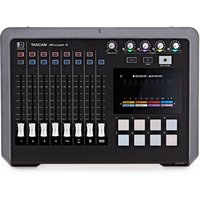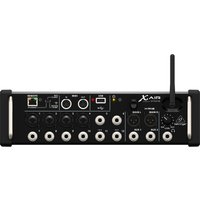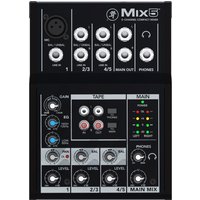
The Tascam Mixcast 4 Podcast Recording Console is an all-in-one solution for podcasting and live streaming featuring built-in trigger pads and Bluetooth connectivity.
Designed for online creatives, the Mixcast 4 is jam-packed with useful features as well as boasting multi-track recording and dedicated software for editing.
Start your podcast today. Your favourite podcasts use a mixing console to record through microphones and process everything for a professional product. The Mixcast 4 gives you all the tools you need in one complete package. You can connect up to four microphones so you can invite guests and have a multi-voice podcast. You can also mix in background music whilst recording, as well as incorporate sound FX, jingles, and other custom sounds via the pads.
No experience? No problem! Using Auto-Mix, Mixcast will automatically set the optimal levels for each microphone so you can get set up and recording within minutes. It is also easy to navigate with an ergonomic control panel and a touch screen display. Not only that, but the Mixcast 4 can be used as an audio interface with 14 inputs and two outputs – perfect for musicians.
Upgrade Today: The new firmware update (version 1.20) is now available with a range of new features and upgrades.
LIMITED OFFER: For a short time only (Until 31st December 2023), Tascam and IK Multimedia are giving customers who purchase this product the T-RackS Porta One. T-Racks Porta One is a powerful software emulation plugin that replicates legendary Tasca and Teac tape recorders, including the Porta One. See below for more details.
More info…
LIMITED OFFER – FREE T-RackS Porta One software
For a limited time only (until 31st December 2023), Tascam has teamed up with IK Multimedia to give customers a chance to claim the powerful T-RackS Porta One software package that replicates the sound and interface of classic Tascam and Teac tape recorders. Capture the iconic sound of Tascam’s Porta One, meticulously recreated for the digital era, capturing its unique recording process with ultra-accurate modelling technology. All you have to do to claim this free software is register this product with Tascam ID.
Podcast and live-streams made easy!
The Mixcast 4 allows you to create professional-sounding podcasts and live streams without the need for advanced technical knowledge. It features a range of tools to achieve this, including ‘Auto-Mix’ which is perfect for those just starting out. With Auto Mix activated, the Mixcast will set the optimal levels for each microphone and set the mic priorities for you. This takes the stress out of podcasting, providing the perfect mix for you every time.
A five-inch colour touch screen display allows you to easily navigate between settings and controls. The intuitive menus make it easy to follow your settings and control different parameters.
New firmware update – Version 1.20
Featuring a whole host of upgrades, enhancements, and new features; the new and improved firmware (V.120) takes your Mixcast 4 to the next level. By popular demand, Tascam has introduced input gain control for USB, Bluetooth, and 3.5mm AUX inputs. This means you can now control all the levels of your inputs for maximum reign over your volumes.
Helping to prevent audio feedback, the new firmware also includes a new ‘automatic mute’ on the monitor output when mic inputs are active. This helps to eliminate any feedback you can incur when using nearfield monitors.
Other improvements include an updated audio level display which now measures sound in dB (decibels) as opposed to the red/green visual indicators. Audio ducking control has also been enhanced. You can now apply ducking control to sound pads, so when they are triggered, the music/mic inputs are automatically lowered for a cohesive sound. You can now also access individual channel settings quickly and efficiently using the front panel channel buttons.
Incorporate custom jingles and sound FX
Featuring eight trigger pads complete with eight customizable banks, the Mixcast 4 allows you to incorporate your own jingles, sound effects, and other audio files at the touch of a button. The Mixcast comes pre-loaded with a range of preset sound effects, but you can easily customize the pads to trigger your own custom sounds. Not only that, but you can also use the sound pads to trigger audio effects such as voice transformers, reverb, and more for instant real-time results.
Stream music via Bluetooth or AUX input
Want to spice up your podcast with music or take calls from guests live on air? You can use the external audio input to process audio from your smartphone, computer, or another audio device. Enjoy echo-free conversations over the phone using the Mix-Minus feature to optimize your sound when talking to guests. You can also stream audio wirelessly from Bluetooth-enabled devices. This can also be used to take calls on-air, as well as incorporate audio files and music.
The complete recording package
Whether you’re a podcaster, live-streamer, or musician, the Mixcast is suited to virtually any recording application. The built-in SD card slot allows you to record up to 14 tracks directly to an SD card, so you can instantly save audio files. It also doubles up as a 16-in/2-out audio interface, so you can use the Mixcast with your favorite DAW.
Advanced controls and editing – Tascam Podcast Editor software
Once you’ve recorded your podcast/live stream, you need to edit it to get the best results. Introducing the Tascam Podcast Editor. This dedicated mixing software allows you to edit your audio tracks and arm tracks, as well as configure custom sound effects and background music for the trigger pads. The streamlined and intuitive design of the software makes it easy, ideal for beginners and professionals alike. The cross-platform software is available for computers and mobile devices, so you can edit no matter where you are.
Specifications
Recorder
Recording media: SD cards (64 MB – 2 GB), SDHC cards (4–32 GB), SDXC cards (48–512 GB)
Recording/playback format: WAV 48 kHz 24 bit 2-channel stereo / 14-channel poly (BWF)
Approximate recording times with 16-GB SD card (in hours:minutes):
– Stereo recording: 16:30
– 14-track recording: 2:20
Analog audio inputs
Mic inputs 1-4: XLR/TRS combo jacks (XLR-3-31: GND, HOT, COLD), 6.3-mm standard TRS jacks (Tip: HOT, Ring: COLD, Sleeve: GND)
Maximum input level: +10 dBu (when LEVEL at min.)
Nominal input level: –10 dBu (when LEVEL at min.)
Minimum input level: –76.5 dBu (when LEVEL at max.)
Gain range: 66.5 dB
Input impedance: 2.1 k ohms
Headset input (TRRS CTIA standard): 3.5-mm 4-pole mini jack
Maximum input level: +4 dBV (when LEVEL at min.)
Nominal input level: –16 dBV (when LEVEL at min.)
Minimum input level: –82.5 dBV (when LEVEL at max.)
Gain range: 66.5 dB
Input impedance: 2 k ohms
Line input (TRRS CTIA standard): 3.5-mm 4-pole mini jack
Maximum input level: +8 dBV
Nominal input level: –12 dBV
Input impedance: 12 k ohms
Line inputs L/R (balanced): 6.3-mm standard TRS jacks (Tip: HOT, Ring: COLD, Sleeve: GND)
Maximum input level: +24 dBu
Nominal input level: +4 dBu
Input impedance: 11 k ohms
Analog audio outputs
Phones outputs 1-4: 6.3-mm standard stereo jacks
Maximum output power: 45 mW + 45 mW (0.1 percent THD+N or less, 32 ohms)
Headset output (TRRS): 3.5-mm 4-pole mini jack (signal mirrors Phones 1 output)
CHECK PRICES AT ZZOUNDS



